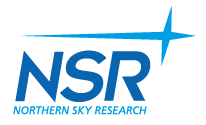New Video Channels Continue to be Main Growth Driver for Satellite Capacity
Thursday, January 24th, 2008
Additional 9,500 Standard Definition and 900 HD Channels to Be Carried by 2012
CAMBRIDGE, MA — In its recently released study covering the entire commercial satellite transponder leasing sector, Northern Sky Research (NSR) projects that worldwide carriage of new standard definition (SD) and high definition (HD) channels for all categories of television services will account for between 75% and 85% of C- and Ku-band transponder demand growth in most regions around the world. NSR projects in its “Global Assessment of Satellite Demand, 4th Edition (GASD)” report that approximately 1,750 additional SD channels and another 150 HD channels will be placed on commercial C- and Ku-band satellite payloads every year for the six-year period between 2006 and 2012. In fact, DTH services alone will contribute nearly 4,000 SD channels and just fewer than 500 HD channels by 2012 according to NSR’s latest industry forecasts.
“Even though many other segments like satellite broadband, cellular backhaul or mobile services are key to industry growth, the simple fact is that plain old channel growth continues to be the bread and butter business for commercial satellite operators,” stated Patrick French, Senior Analyst for NSR and author of the report. “Year after year, NSR tracks strong growth in the video markets, and new technology advances like MPEG-4 and DVB-S2 just barely slow down the pace of transponder demand growth from the addition of new channels.” NSR is even beginning to see the reverse trend as adoption by consumers of large screen flat panel TVs is forcing some broadcasters to improve even their SD signals so as to keep viewers happy about picture quality. “Today only a small minority of broadcasters has upped the bandwidth used for carriage of their standard definition channels,” said French, “yet this could be the thin edge of the wedge with this specific trend gaining momentum in the coming years as picture quality becomes a competitive advantage as important as channel choice.”
Even if the global trends are positive for video markets, NSR does note some areas to be closely monitored by the industry. “The launch of new DTH platforms in the last two to three years has truly been incredible,” reported French, “yet some countries are now seeing three, four and even more competing DTH services plus cable and other new pay-TV offerings. Some consolidation is inevitable, it is just a question of who and when.” NSR’s study also closely tracks the migration of analog channels and feeds to digital. “Most of the converted analog capacity gets repurposed by the client, yet there are occasions when contracts are cancelled or not renewed, and this can impact transponder demand in specific markets like the USA or Germany,” according to French. “Still, the long-term fundamentals are solid in the video sector, and these tend to be more short-term issues.”
About The Report
NSR’s GASD 4th Edition study provides the industry with the most detailed satellite capacity analysis available of multiple applications including video distribution, DTH, video contribution & occasional use television, telephony & carrier services, broadband services for enterprises, Internet access and IP trunking, narrowband VSAT services, and a group of other niche satellite services. A total of twelve regions are investigated in the study with separate C- and Ku-band demand forecasts undertaken for each of the seven major satellite applications addressed plus an assessment of commercial Ka-band demand in pertinent markets. Whenever possible, NSR made use of a bottom-up market evaluation methodology so that the root demand drivers and restraints would feed directly into the market assessment. The study provides a highly granular evaluation of demand for C-, Ku- and Ka-band satellite transponder capacity with over 200 demand forecasts readily accessible in accompanying Excel files.
Latest News
- Slovak Telekom and T-Mobile CZ upgrade video streaming with 24i
- CTV/OTT expected to be fastest growing media channel in U.S. in 2024
- Red Bee Media provides WWTV program and schedule data to REELZ
- WISI Communications initiates restructuring in self-administration
- Eutelsat distributes LGCC TV channel to Europe and MENA via satellite
- Akamai rolls out NVIDIA-powered Cloud services optimized for video processing